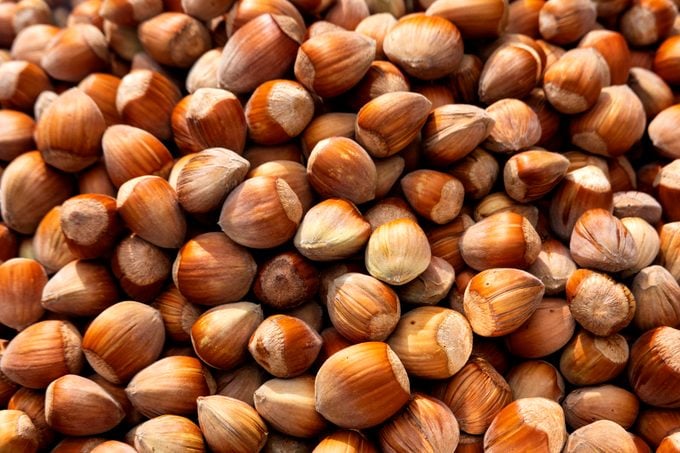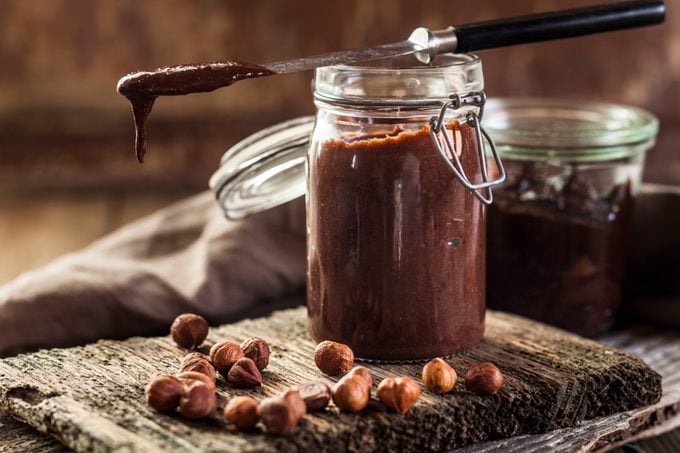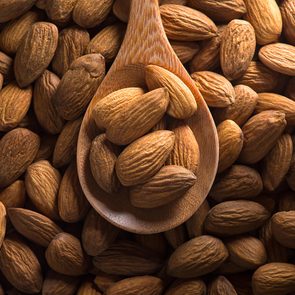Are Hazelnuts Healthy? Here’s What Nutritionists Say
Updated: May 12, 2021
Hazelnuts are tree nuts loaded with rich nutrients and healthy fats that can provide numerous health benefits. Here's what you need to know.
Hazelnut: An underrated nut
What’s the first thing that comes to mind when you think of hazelnuts? Probably a lip-smacking hazelnut-chocolate spread like Nutella. Just the thought of spreading it on toast or over strawberries makes your mouth water, doesn’t it?
But beyond such sugar-laden products is a healthy and nutritious treat all on its own: the hazelnut. As with other nutritious nuts, hazelnuts have been trending up lately. Both demand and production increased over the past 10 years—in the United States, hazelnut crops have increased 55 percent from a decade prior, according to the International Nut and Dried Fruit Council Foundation. Even better, it’s sustainably produced in the U.S.
“Hazelnuts are often overlooked and not as frequently consumed by most people, but they’re loaded with nutrition,” says Roxana Ehsani, a Nevada-based registered dietitian nutritionist and spokesperson for the Academy of Nutrition and Dietetics. “They’re a great source of fat, fiber, and protein.” (These are the healthiest nuts you can eat.)
That combination of nutrients “helps us to stay fuller for longer, whether we’re having hazelnuts as a snack or including them in a meal,” says Toronto-based registered dietitian Lauren McNeill, RD, of Tasting to Thrive Nutrition & Wellness. “Plus, they taste delicious.”
Here’s a closer look at hazelnut nutrition, benefits, and ways to eat it. Plus, we have a hazelnut recipe for a healthful chocolate-hazelnut spread.
Where hazelnuts are grown and harvested
Hazelnuts, also called filberts, grow all over the world, with the native American hazelnut spread over much of the eastern and central regions of North America. But the kind that is cultivated for consumption, the European hazelnut, grows mostly in Turkey, which produces over 60 percent of the world’s crop. The U.S. produces about five percent of the world’s crop—and 99 percent of that is grown in Oregon.
European hazelnuts, which have thinner shells and larger nuts than their American counterparts, like a temperate climate—not too hot, not too cold—which is why Mediterranean countries like Turkey and Italy grow hazelnuts so well. Farmers didn’t find a suitable place for hazelnuts to grow in America until they were brought to Oregon’s Willamette Valley in the mid 1800s, where it continues to thrive today. In fact, 2020 was a record year, with a huge crop that the USDA estimated at 71,000 tons, up a whopping 61 percent from 2019.
In Turkey, hazelnuts are harvested by hand. In the U.S., however, mechanical harvesters pick up and sort out the nuts from the ground after they fall naturally, with no need to “shake” the trees.
(Nuts are one of the many brain foods that can make you smarter.)
One blight on the hazelnut industry
The one problem with growing European hazelnuts in the U.S. is that they’re susceptible to Eastern filbert blight, a fungal tree disease that can damage orchards; American hazelnut trees are more resistant to it.
Since the disease became a problem for crops in the 1960s, agricultural scientists have been looking for ways to combat the problem, including creating hybrids with the American variety that have better resistance to the disease.
Hybrid varieties might also help expand the growing potential of other areas of the country. Now, most places are too cold to support hazelnut growth. But certain hybrids might be hardier.

Hazelnut nutrition facts
Part of the reason for hazelnuts’ rise in popularity is that this plant-based snack can be part of a healthy diet. Here’s the nutritional value per 28 grams (about one ounce) of hazelnuts, and their daily value (DV).
Calories: 176 (9 percent of DV)
Total fat: 17 g (27 percent DV)
Cholesterol: 0 mg (0 percent DV)
Sodium: 0 mg (0 percent DV)
Carbohydrate: 4.68 g (2 percent DV)
Dietary fiber: 2.72 g (10 percent DV)
Protein: 4.19 g (8 percent DV)
Notable nutrients of hazelnuts
“Hazelnuts are a good source of vitamins and minerals,” Ehsani says. “They provide a high dose of manganese, which protects cells from damage, aids in bone health, and helps keep our immune system healthy.”
In addition, hazelnuts are a great source of healthy fats, protein, fiber, magnesium, and vitamin B6, McNeill says. “Hazelnuts are particularly high in magnesium and vitamin B6,” she adds.
“Magnesium is a nutrient that many people may not be getting enough of,” says McNeill. It “plays an important role in muscle and nerve function, converting food into energy, helping with protein formation, and helping with nervous system regulation. Vitamin B6 plays an important role in mood regulation, immune system function, and preventing certain types of anemia.”
Healthy fats, fiber, and protein
Hazelnuts are similar to other nuts in their nutrient composition, Ehsani says. They contain a high dose of good-for-you fats and a few grams of both protein and fiber, all while being low in carbohydrates.
“Hazelnuts contain heart-healthy fats—monounsaturated and polyunsaturated fats, including omega-3s, a type of fat the body needs to get from food,” she says. Fats help with the absorption of certain nutrients and hormone regulation.
Plus, “hazelnuts also contain four grams of protein, a macronutrient needed to maintain your muscles, bones, and repair tissue,” Ehsani says. Protein is also important in building hormones and enzymes, and keeping proper fluid balance in the body, adds McNeill.
In addition, hazelnuts are a good source of fiber, which “helps us to stay fuller for longer, helps keep our blood sugar stable, and helps with regular bowel movements,” McNeill says.
Potential benefits of hazelnuts
Lower cholesterol
All of these important nutrients translate into major health boons and disease prevention. One of the biggest benefits of nuts including hazelnuts is lowering cholesterol.
“Hazelnuts are rich in heart-healthy monounsaturated and polyunsaturated fats which can help lower bad cholesterol, specifically total and LDL cholesterol,” Ehsani says. “They also contain fiber, which can bind both total and LDL cholesterol in the gut to be eliminated by the body.”
In one small study, published in 2018 in Clinical Nutrition, researchers found that feeding hazelnuts to children with primary hyperlipidemia (high levels of fat particles in the blood) was effective in lowering cholesterol over an eight-week period. Meanwhile, a review of studies in a 2016 issue of Nutrients, found hazelnuts had a cholesterol-lowering effect in adults, as well. The review included nine studies with 425 adults who participated in an intervention diet that lasted 28 to 84 days with hazelnut consumption ranging from 29 to 69 grams per day.
(Also try these foods that lower cholesterol.)
Protect heart health
These cholesterol benefits mean hazelnuts are good for your heart. In addition, “hazelnuts are rich in potassium and fiber, which help support and maintain healthy blood pressure,” says Ehsani.
Although much of the research on nut health benefits is funded by the nut industry, many studies, including one published in 2017 in the Journal of the American Medical Association, have shown that nut consumption is associated with a lower risk of death from heart disease, stroke, or diabetes. A study published in 2019 in Circulation found that eating nuts, including hazelnuts, was linked with a lower risk of heart disease among people who had diabetes.
Help prevent cancer
Research is also looking at how the antioxidants in nuts—specifically, hazelnuts—might help cells ward off damage that can lead to cancer. “Hazelnuts are a good source of antioxidants, which help protect and fight off oxidative stress that causes diseases like cancer,” says Ehsani, echoing the results of a review of studies in a 2016 issue of BMC Medicine that found an association between nut consumption and a lower risk of diseases, including cancer.
These beneficial antioxidants include vitamin E. In one study (funded in part by the Hazelnut Marketing Board of Oregon), older adults who ate hazelnuts increased their levels of vitamin E.
But hazelnuts also contain another antioxidant more unique to hazelnuts. “Unlike other nuts, hazelnuts have the highest amount of antioxidants known as proanthocyanidins,” Ehsani says. “These compounds help fight off and reduce inflammation in the body, which can help protect the body against developing disease.”
Plus, “its dose of omega-3 fats also helps reduce inflammation in the body,” she adds. “To gain all of hazelnuts’ cancer-preventing properties, it is best to consume the nut raw and with its skin on it.”
(Try these foods that may help prevent cancer.)
Boost weight loss
Research, including a study published in 2019 in BMJ Nutrition, Prevention & Health, found that although they are higher in calories, nuts such as hazelnuts, can actually help you maintain a healthier weight. That’s as long as they’re eaten in moderation.
“Hazelnuts can help with weight control thanks to its fiber-filling properties,” Ehsani says. “Dietary fiber is digested slowly by our gut, which leaves us feeling full longer. Foods rich in fiber can help keep a person more satisfied than low-fiber foods, thus aiding in weight maintenance.” In addition to fiber, “protein-rich foods fill you, so you eat less, thanks to its satiating properties,” she says.
And hazelnuts’ “combination of protein, fiber, and healthy fats helps to keep our blood sugars stable, which helps us feel fuller for longer and more satisfied,” McNeill says.
(Here are some foods nutritionists eat every day.)
Concerns with eating hazelnuts
If you’re allergic to tree nuts, stay away from hazelnuts. Not sure if you are? Then watch out for signs of an allergic reaction, including trouble breathing, mouth or throat itching, abdominal pain or diarrhea, or shortness of breath. If you have an epinephrine pen (EpiPen), administer it, and seek emergency care.
Because hazelnuts have significant calories, stick to the recommended 1/4-cup allowance per day.
“Hazelnuts, like other nuts and seeds, are nutrient-dense, but high in calories due to their high fat percentage,” says Ehsani. “Be mindful of portion size and consider measuring out 1/4 cup of hazelnuts before consuming them straight out of a large container or bag.”
How to eat them
With hazelnuts, the possibilities are endless. “Hazelnuts are very versatile,” Ehsani says. “They can be added to most dishes, sweet or savory. They can be added whole, chopped, sliced, or ground up. You can try them raw or roasted.”
Specifically, “hazelnuts can be used in homemade granola bars, energy balls, crushed on top of salads or bowls, eaten as a snack, or made into homemade spreads,” McNeill says. Hazelnuts are also yummy over pasta or as ground as a crust for meats.
You can also try hazelnut milk or hazelnut oil.
“Hazelnut milk can be used just like another milk or non-dairy milk product. It may taste especially delicious in coffee or tea,” Ehsani says. “You can also use hazelnut oil, although it shouldn’t be heated up due to its low smoke point and the delicate oils it contains. But you can use it to make your own salad dressing or drizzle it onto foods.”
What about Nutella?
Nutella can be enjoyed, McNeill says, but in limited quantities. “While Nutella is delicious, it is also high in sugar, so enjoy it occasionally,” she says.
Ehsani agrees that Nutella does contain a significant amount of sugar per serving. Once you see Nutella’s ingredients, you may think twice about eating it.
“Two tablespoons of Nutella contain 21 grams of sugar, which is equivalent to five teaspoons of sugar,” she says. “However, there are a lot of healthier chocolate hazelnut spreads out there. Look for one that contains less sugar, or try making your own at home.”

Healthier Hazelnut Chocolate Spread
Recipe by Roxana Ehsani
Ingredients:
2 cups of raw hazelnuts
½ cup of milk (unsweetened almond, oat, or regular milk would all work)
4 tablespoons of oil (such as hazelnut oil, sunflower seed oil, or safflower oil)
3 tablespoons of maple syrup or honey
1/3 cup of unsweetened cocoa powder
1 teaspoon of vanilla extract
Instructions:
Roast the hazelnuts for eight minutes at 400 degrees F, until lightly toasted. Once slightly cooled, rub off the skins of the hazelnuts using a paper towel, until most of the skins come off. In a food processor, blend the nuts for several minutes until finely ground. Add the remaining ingredients to the blender and blend until mixture reaches butter-like consistency. Enjoy!
Here are some other hazelnut recipes to enjoy:





















